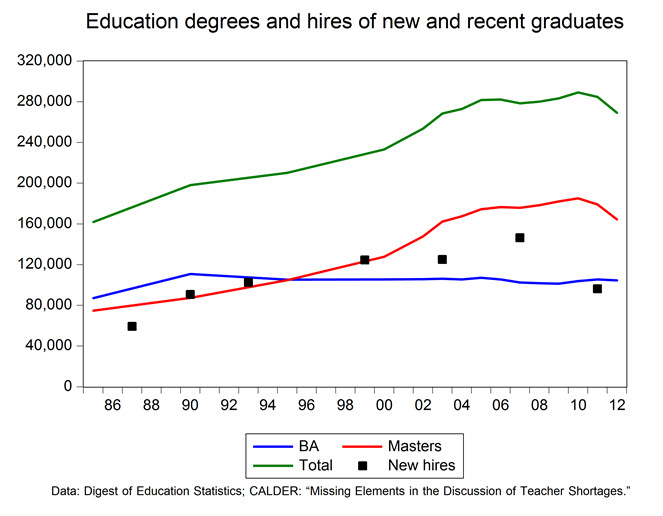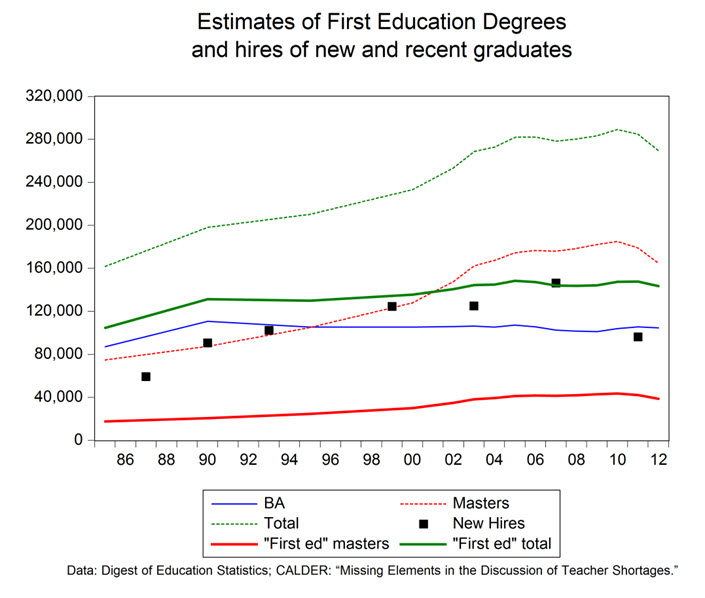Here’s a question to consider: Are teacher shortages…
A. Real?
B. Imaginary?
C. Both?
D. Neither?
Are we facing a nationwide teacher shortage? What do we mean by “shortage”—or, better, what should we mean? Let’s put some numbers on the Chalkboard, and then back up a bit and ask whether we’re asking the right questions.

The figure shows the annual production of bachelors and master’s degrees in education. The most recent numbers are about 270,000 degrees per year. Compare this to the number of new teacher hires of current or recent graduates, which ran just under 150,000 in 2007. (New hires data courtesy of Dan Goldhaber, from the new CALDER Explainer “Missing Elements in the Discussion of Teacher Shortages.”) While the new hire data is only available every few years (it’s derived from the School and Staffing Survey (SASS)), we can take an educated guess that the low 2011 square is an anomaly and that the number of new hires is now back up at about pre-recession levels.
Conclusion from the graph? The green line is way above the black squares. We learn that we’re producing two or three times the number of teachers that we currently need. If that’s right, resources are being wasted.
Of course, not all teachers have degrees from education schools. So I took a look at numbers from the most recent SASS. 80 percent of teachers have a BA from an education school. Of those who don’t, 76 percent have a master’s from an ed school. So the fraction of teachers without any kind of ed degree is
0.20×0.24=4.8%
This number is a little rough as it comes from one survey taken at single point in time, but it’s safe to say that there are only a few people becoming teachers without some kind of education degree. So while new supply is actually higher than the green line, it’s not all that much higher.
However, most master’s degrees in education go to teachers who want further training or who want the pay bump that comes with a graduate degree. While we don’t know the educational background of graduate students in education, we can use the most recent SASS to find out how many teachers who got MAs in education already had a BA in education. The answer is 76.4 percent.
Suppose we take, as a ballpark number, that all but a quarter of MAs in education are “redundant.” This does not mean that they aren’t valuable, just that they aren’t adding to the number of new teachers produced. I’ve made this adjustment in this next graph, lowering the number of “first ed” masters as well as the total. With this adjustment, the production of first-time education degrees has been pretty flat at about 145,000. That’s somewhere around the number of newly hired teachers. In other words, the flow of new teachers supplied each year is roughly the same as the demand for new teachers.

In the short run, newly trained teachers are not the only source of supply. Slots can also be filled by hiring back experienced teachers who have left the profession temporarily. In fact, something like half to two-thirds of openings are filled that way. But in the long run, the annual supply has to meet or exceed the annual demand. We may be moving closer to a national teacher shortage than it first appears.
Now let’s turn to the question of whether talking about a “national teacher shortage” even makes any sense.
You can have a shortage in specific kinds of instructional needs, STEM teachers for example, or shortages in particular areas of the country, without there being a national shortage. On the first point, the “Missing Elements” CALDER Explainer shows that teacher production for both STEM and special education has been relatively flat for a very long time. With regard to geographic variation, Chalkboard reader Jason Dyer comments “Oklahoma has given out 842 [emergency certificates] this year alone, more than the last four years combined).” Dyer goes on to point to current teacher shortages in Nevada as well as Oklahoma.
In other words if you’re a principal trying to hire for a specific slot and not getting any applicants, words about overall national availability provide little comfort.
The second point is that discussing quantity without discussing quality is a mistake. Oklahoma only has about 41,000 teachers. If the state issued emergency certificates in a single year to more than two percent of the teacher corps, one can’t help but worry if teacher quality is at risk.
The U.S. can always get “enough” teachers. Just lower standards enough. On the flip side, even when we produce more than enough bodies to fill classrooms, that doesn’t demonstrate that all or most of the new teachers have the skills and drive for the tough job of running a classroom.
In the private sector, salaries get adjusted to get enough, good enough employees. That doesn’t happen in public schools. Rather than talking about shortages in terms of body count, we should be asking whether we are producing (and retaining) enough really, really good people in the classroom. Quantity matters when it comes to teacher supply, but it’s a mistake to talk about quantity without talking about quality at the same time.



Commentary
Are we facing a nationwide teacher shortage?
November 9, 2015